The book A Taxonomy of Office Chairs was a wonderful surprise for us when it was first published in 2011. We were excited to see the history of office chairs being told through the story of their components. Classifying backrests, armrests, seats or bases, and systematically tracing their evolution in schematic drawings gave new meaning to the components themselves. There is no other book that speaks of humble chair parts with such depth and respect.
Now, about ten years after the publication of A Taxonomy of Office Chairs, we have the opportunity to complement it with a small publication commissioned from the same author, Jonathan Olivares. In A Taxonomy of Office Chairs: Outtakes, Scraps and Updates, Olivares shows us some of the process behind the book, personal anecdotes that didn’t fit within the book’s taxonomical structure, and updates on what has happened in office sating during the last decade.
An interview with Jonathan Olivares
Designer Jonathan Olivares and Eckart Maise speak about a scientific approach to documenting office chairs, the significance of their components, and about the qualities of the three-minute chair.
Jonathan, you published the book A Taxonomy of Office Chairs in 2011. How did you come up with the idea of looking at office chairs in such detail back then?
In 2006 I was in my first studio, in my mother’s garage, and I was spending long hours asking myself a lot of questions. I wondered about the origin of some of the things that we take for granted in design. For instance, a height adjustable armrest—I wanted to know where did it really come from. It seemed to me that in the US at the time the office chair was the most ubiquitous, most complex, and perhaps the least understood object. So, the typology seemed to me to be a perfect subject to study comprehensively.
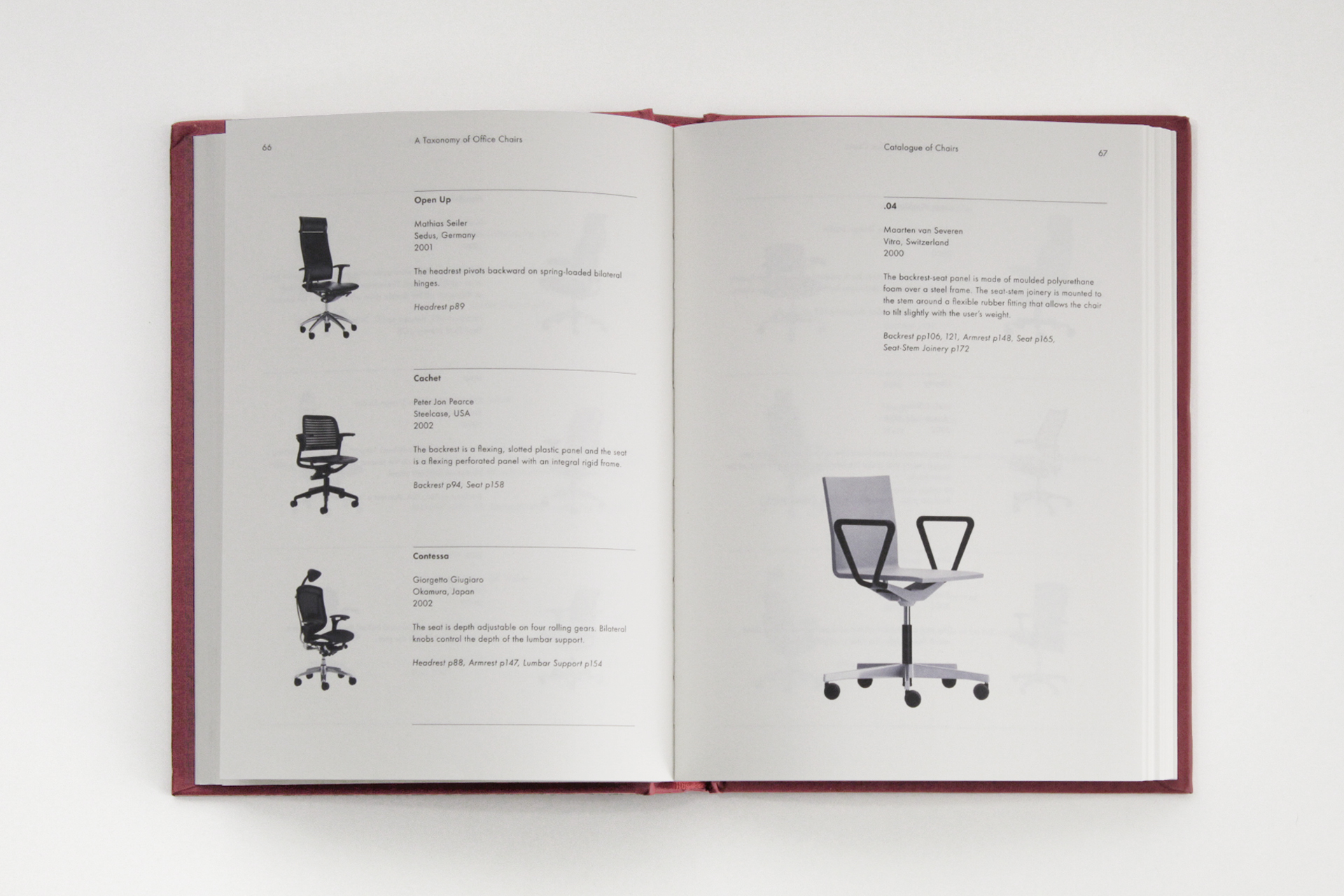
A Taxonomy of Office Chairs, Phaidon Press 2011 (out of print)
What was the significance of chair components in this context?
The first impetus for the book was the realization that office chairs are made of components, and that a component from one chair may relate to a similar component on an otherwise vastly different chair. So, the book is really a study of chair components.
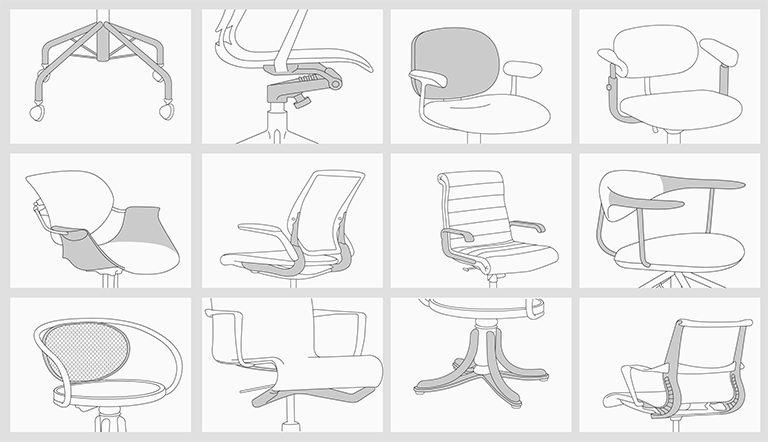
Office Chair Components, drawings by Jonathan Olivares
The book was the first taxonomy of a man-made object and introduced the concept to the field of design. Why did you choose this scientific approach, as previously only biologists or zoologists did in their field?
Taxonomies offer a powerful and potentially objective lens for the field of design. Morphological taxonomies, which study the shapes of plants and animals, were rendered obsolete by DNA, but the format is very useful for studying designed objects. I was also interested in exploring an altogether new format for design history, which is usually based somewhat on taste and scholarly versus scientific analysis. As I built up my own library of books on design, I couldn’t help but feel that these books were written for other scholars, but rarely had the kind of information that would be most relevant to designers. Recently a friend who works as a chef was over at my house, picked up a copy of the book, and asked if it was a manual for industrial designers—it was a perfect compliment.
How was the book received?
The book gained almost an instant cult-status in the design industry. Alice Rawsthorn reviewed the book for the New York Times / International Herald Tribune when it came out, without so much as asking me a single question about it, and totally captured the books intention and spirit. The book is now out of print. Since the book’s release a number of prominent design exhibitions and publications have used taxonomical structures as their organizational system, which is very pleasing to see.
The first chapter of your book is called The evolving office chair. What set of factors have influenced this evolution and what were the biggest milestones in the evolution of office chairs?
Office chairs offer a mirror to society and how it changes. The earliest office chairs embraced Fredrick Winslow Taylor’s ideas around scientific management. The post war years produced numerous chairs that used war time technologies. During the seventies, as white collar work became more common, and consumer awareness grew, the field of ergonomics had great influence on office seating. Many people refer to the 1994 Aeron chair as the dotcom throne. Today sustainability and loosened work practices are apparent in the latest office chair models.
What did you find particularly challenging during your research?
Identifying the first instance of a given feature was particularly challenging. To do so you had to find a feature, and then look at all the chairs released around that time and before to see which may have been the first. And companies keep really scant archives if any at all, so tracking down original catalogs was very challenging. Speaking with industry veterans, while you are relying on memory, was essential.
Were there aspects that you did not address in your book?
I considered adding a section that would explain materials and processes, so that the average reader could understand what die cast aluminum or injection molded plastic is, but we ran up against page count limitations, and decided to keep the book focused on chair components.
There could have been a separate book on the inner workings of office chair mechanisms. With few exceptions, the designers I interviewed had only a basic grasp of what was happening inside their chair mechanisms, with company engineers and external suppliers holding the knowledge. By the time I realized that I should have been interviewing external mechanism suppliers my deadline was fast approaching and my research budget had run out. A company like Donati would have been most helpful to speak with.
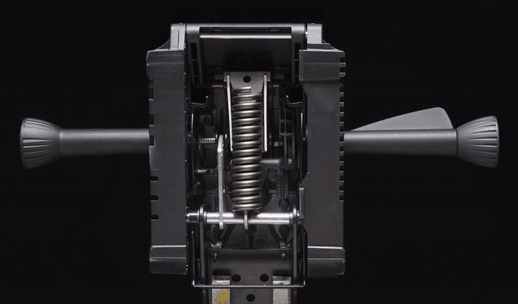
Looking inside an office chair mechanism
You not only dealt intensively with components during the research, you also created more than 400 illustrations for the book yourself. Has this helped you to become a better designer?
Doing the 400 or so illustrations in the book taught me a very valuable lesson about simplicity and complexity. I found that the chairs that could be drawn in a minute or less were often too simple to keep my attention. The chairs that took more than there minutes to illustrate were too complicated.
The three-minute chair— Jørgen Rasmussen’s Kevi, The Eames Time Life Chair, the Morrison Hannah chair for Knoll, and Richard Sapper’s Sapper Chair—these were the chairs with the right balance of simplicity and complexity that could keep my attention while remaining easily legible.
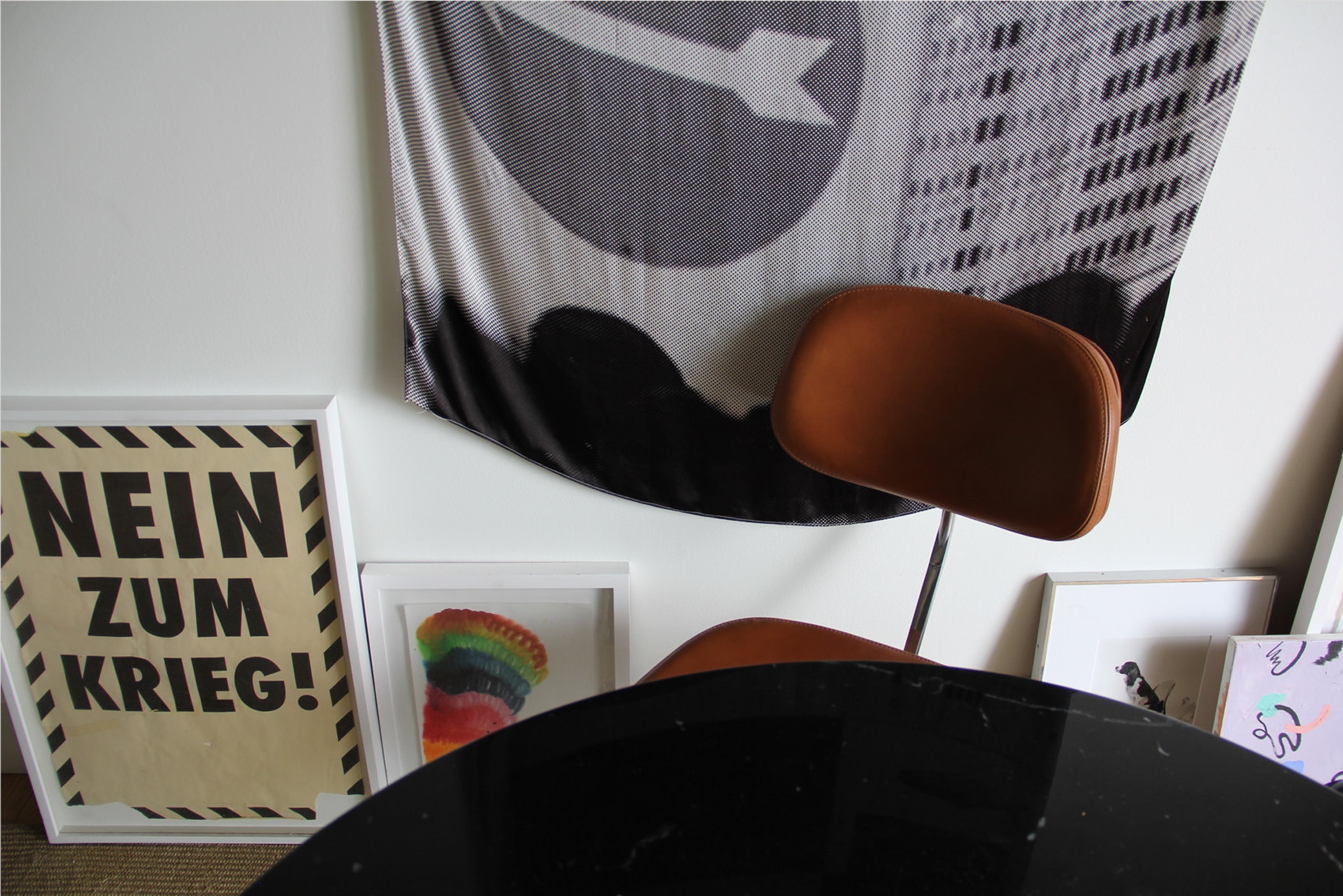
A three-minute chair (Kevi Chair, Design: Jørgen Rasmussen) in the author’s office
And was there a ten-minute chair? Which chair was the most difficult to draw?
The backrest on the Embody Chair took the better part of an hour to illustrate. Not fun.
You met many great designers during the research for the book. Which encounter do you remember most vividly?
Perhaps meeting Don Chadwick in Los Angeles in 2008 had the greatest impact on my life. The way he spoke about Los Angeles, a city of the future, with abundant aerospace and Hollywood manufacturing resources, ultimately convinced me to move to L.A. where I have spent the last decade practicing.
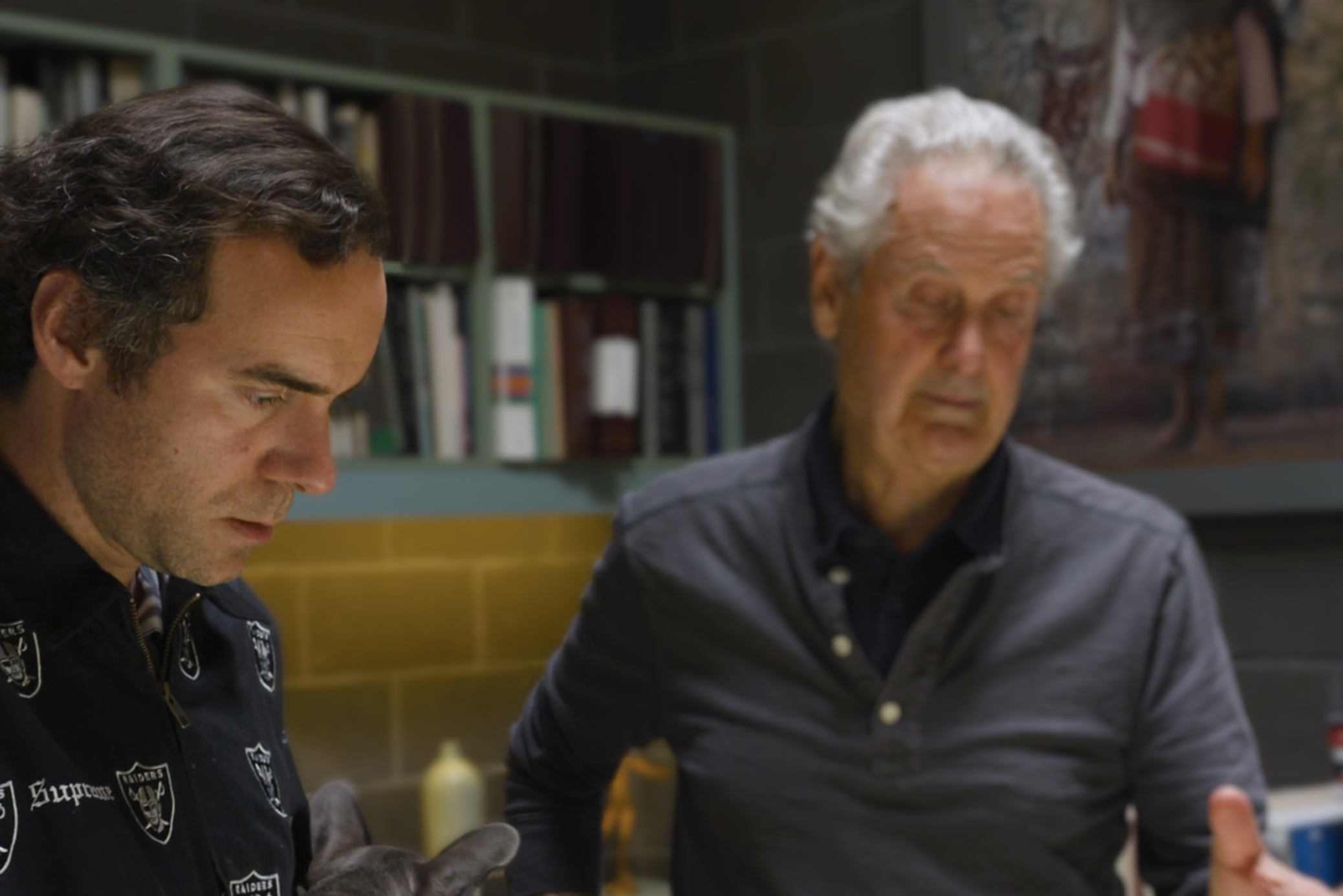
Designer Don Chadwick (right) and Jonathan Olivares in Chadwick’s studio (from 2019 film by Michael Cukr / Apartamento)
Can you tell us more about the new publication?
The tenth anniversary of the book had me reflecting, and thinking about whether to issue a new edition, with the significant chairs that have been released in the last decade and updated chapters. After consideration I decided that it would be more interesting to issue a companion publication, like a fanzine to the original book, and that is how Taxonomy of Office Chairs: Outtakes, Scraps and Updates got started.
The Taxonomy book was originally commissioned as an internal report for Knoll, so I did my best to take my own personality out of the book, to be as objective as possible. In some ways the book’s qualities—scientific, obsessive, nerd-core—defined my practice in a lot of people’s eyes, but I don’t, and never did, associate with those qualities at all. So, Outtakes, Scraps and Updates is intended to show the more human side of that book’s process, it is a subjective scrapbook that is more in line with how I look at things today.
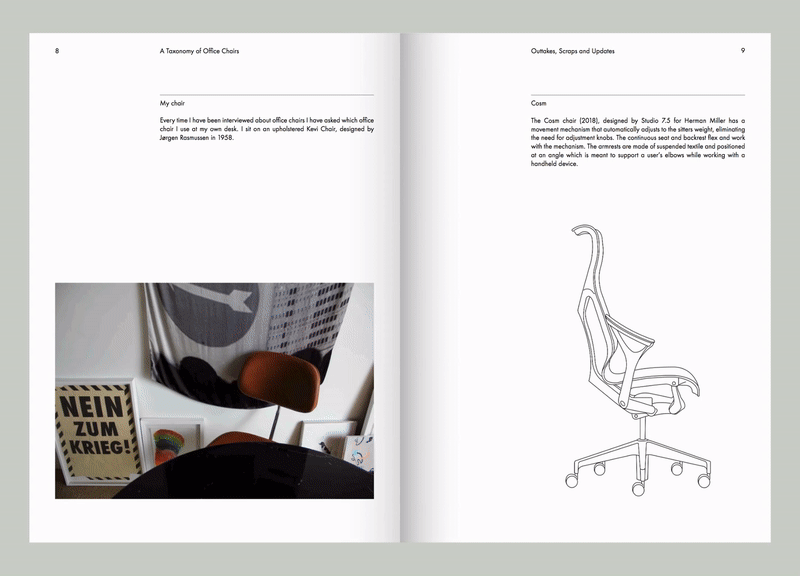
Pages from “A Taxonomy of Office Chairs: Outtakes, Scraps and Updates”
And what has changed for office chairs in the last ten years?
The last decade has seen tremendous changes. Mobile technology made work less sedentary, co-working became prevalent, the pandemic forever altered our ideas of where and how work can take place, and the gaming industry has also created a new market and new parameters for office chairs.
Have you already designed an office chair yourself? If not, what would it look like?
I haven’t, but if I did I know it could be illustrated in exactly three minutes.
We are looking forward to that chair becoming a reality one day. Thank you for the interview, Jonathan!
Jonathan Olivares is an industrial designer based in Los Angeles. Recent projects include a showroom for Kvadrat in New York City (2022), the publication Seeing published by Nieves (2022), a retail shop for Camper (Rockefeller Center, 2019), the installations Brujas Training Facility (Performance Space New York, 2018) and Room for a Daybed (Kortrijk Biennale Interieur, 2016). Olivares’ work has been published internationally, granted design awards—including Italy’s Compasso d’Oro—and is included in the permanent design collections of the Art Institute of Chicago, the Los Angeles County Art Museum, and the Vitra Design Museum.
Eckart Maise is an independent consultant and curator based in Basel. He works with the furniture industry, cultural institutions and design studios on creating value where design, brand and business overlap. In his earlier career, he helped build the Vitra Design Museum and led Vitra’s product collections and brand for many years.
The publication A Taxonomy of Office Chairs: Outtakes, Scraps and Updates was published by Jonathan Olivares and made possible by the generous support of Donati. For your personal copy please write to: info@donati.eu